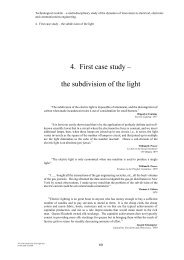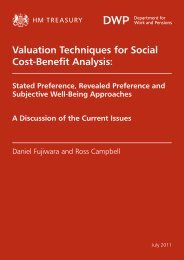NAO Good Practice Guide - Tackling external fraud - HM Treasury
NAO Good Practice Guide - Tackling external fraud - HM Treasury
NAO Good Practice Guide - Tackling external fraud - HM Treasury
You also want an ePaper? Increase the reach of your titles
YUMPU automatically turns print PDFs into web optimized ePapers that Google loves.
6 <strong>Good</strong> practice in tackling <strong>external</strong> <strong>fraud</strong> | Deterring and preventing <strong>external</strong> <strong>fraud</strong><br />
Strengthening internal controls and checks<br />
2.13 It is important that the effectiveness of<br />
controls is continually reviewed. Controls which<br />
have traditionally worked well in countering <strong>fraud</strong><br />
may no longer be effective where <strong>fraud</strong>sters have<br />
launched determined attacks. Detected cases<br />
of <strong>fraud</strong> may show that <strong>fraud</strong>sters are using new<br />
methods to circumvent controls indicating that<br />
these need to be strengthened. Internal Audit’s<br />
work may also identify system weaknesses which<br />
could lead to <strong>fraud</strong>.<br />
2.14 In 00 , the NHS Counter Fraud Service<br />
set up a Fraud Prevention Unit to identify specific<br />
areas of weakness in systems, recommend policy<br />
changes where appropriate and issue instructions<br />
and guidance to make them less vulnerable to<br />
<strong>fraud</strong> (Figure 19). A recent <strong>fraud</strong> prevention<br />
review involved the Unit examining the processes<br />
within trusts for identifying chargeable overseas<br />
visitors. The findings and recommendations from<br />
the <strong>fraud</strong> prevention review have been provided to<br />
the Department of Health to help with developing<br />
further regulations and guidance. The latest <strong>fraud</strong><br />
prevention instruction issued by the Unit arose<br />
from an investigation into an allegation of <strong>fraud</strong><br />
that a Primary Care Trust was being falsely<br />
invoiced for services. The investigation led to<br />
the introduction of standard claim forms, which<br />
include counter <strong>fraud</strong> declarations.<br />
Figure 19<br />
The methodology used by the NHS<br />
Counter Fraud Service Fraud<br />
Prevention Unit<br />
Action by the Fraud Prevention Team<br />
1 Identify possible areas of high risk of <strong>fraud</strong> in the<br />
NHS arising from system weaknesses. Sources<br />
will include the staff within the Counter Fraud<br />
Service including the Central Intelligence Unit, Risk<br />
Measurement Team, Quality Team and feedback<br />
from Local Counter Fraud Specialists.<br />
2 Research the areas of system weakness and<br />
establish the amounts at risk.<br />
3 Organise a programme of visits to selected NHS<br />
Trusts to gain experience of how the systems<br />
work in practice.<br />
4 Issue questionnaires to NHS Trusts to assist in<br />
identifying the scale of any system weaknesses.<br />
5 Collate the findings and recommendations from the<br />
research, reviews and questionnaires.<br />
6 Issue instructions, best practice guidance and/or<br />
recommend policy change taking into account the<br />
amounts at risk.<br />
7 Request compliance statements from NHS<br />
Trusts to provide assurance that good practice is<br />
being applied.<br />
8 If appropriate, recommend that Local Counter Fraud<br />
Specialists carry out proactive <strong>fraud</strong> prevention<br />
work into the areas of high risk identified.<br />
9 Measure the financial impact of the introduction of<br />
any new procedures.<br />
10 Report findings, recommendations and action<br />
taken to Counter Fraud and Security Management<br />
Service policy, operational, and intelligence services<br />
as appropriate.





![AIRTO [Professor Dr Brian Blunden] - HM Treasury](https://img.yumpu.com/15492848/1/184x260/airto-professor-dr-brian-blunden-hm-treasury.jpg?quality=85)










